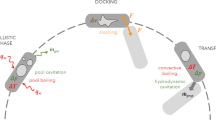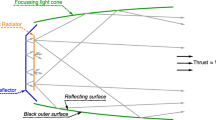Abstract
The interstellar medium (ISM) represents the next frontier in space exploration, with many new discoveries to be made. The challenge, being so far away from Earth, the ISM requires many decades to reach. To advance our knowledge of what exists beyond our solar system, new approaches for rapid access are required. One such approach is solar thermal propulsion (STP). The approach uses several Venus and Earth gravity assists to fly to Jupiter and use its gravity well to dive towards the Sun. Approaching within three solar radii a perihelion burn would be performed, maximising the spacecraft’s ΔV to achieve high solar system escape velocities. A unique aspect of the STP mission concept is that the Sun is used not only as a gravity well for an Oberth manoeuvre, but also to heat the fuel to ultra-high temperatures (> 3000 K), enabling a monopropellant burn with high specific impulse (Isp). Prior preliminary studies indicated escape velocities of over 20 astronomical unit (AU)/year would be possible. An in-depth modelling exercise was undertaken to determine how such a system would perform. The model in this paper showed the current STP design is capable of providing just under 9 ± 1 AU/year, but there are many technology developments that could increase escape velocity. The technologies vary from items that could be implemented in the near term, like turbo-pumps driven by the hydrogen, to items requiring more extensive development programs like thin coatings which do not erode in superheated hydrogen. After reviewing the STP approach, and comparing it to a solid rocket motor (SRM), it was found that with currently available technology, SRM outperforms STP with an escape velocity of approximately 10–12 AU/year. However, future advances in heat exchanger lining materials, turbo pumps, and advanced heat exchanger geometries may enable solar thermal propulsion to provide higher escape velocities, providing one of the fastest ways to exit the solar system. Ultimately, if all technology paths could be implemented with minimal side effects, the performance in a best-case scenario could reach up to 16 AU/year.








Similar content being viewed by others
Change history
27 August 2021
A Correction to this paper has been published: https://doi.org/10.1007/s42423-021-00084-3
Abbreviations
- AU:
-
Astronomical Unit
- ACS:
-
Attitude control system
- C/C:
-
Carbon–carbon
- DOD:
-
Depth of discharge
- DSM:
-
Deep space maneuver
- IMLI:
-
Integrated multi-layer insulation
- ISM:
-
Interstellar medium
- ISMP:
-
Interstellar medium probe
- I sp :
-
Specific impulse
- KBO:
-
Kuiper belt object
- RVC:
-
Reticulated vitreous carbon
- RTG:
-
Radioisotope thermoelectric generator
- SOFI:
-
Spray-on foam insulation
- SRM:
-
Solid rocket motor
- STP:
-
Solar thermal propulsion
- TVC:
-
Thrust vector control
References
Etchegaray MI (1987) Preliminary scientific rationale for a voyage to a thousand astronomical units. In: NASA STI/Recon Technical Report N, vol 87
Alkalai L, Stone E, Freedman L (2015) Science and enabling technologies to explore the interstellar medium. Keck Institute for Space Studies, Pasadena. https://kiss.caltech.edu/final_reports/ISM_final_report.pdf
Jaffe LD, Ivie CV (1979) Science aspects of a mission beyond the planets. Icarus 39(3):486–494. https://doi.org/10.1016/0019-1035(79)90156-8
Gurnett DA, Kurth WS, Burlaga LF, Ness NF (2013) In situ observations of interstellar plasma with voyager 1. Science 341(6153):1489–1492. https://doi.org/10.1126/science.1241681
Fountain GH, Kusnierkiewicz DY, Hersman CB, Herder TS, Coughlin TB, Gibson WC, Clancy DA, DeBoy CC, Hill TA, Kinnison JD, Mehoke DS, Ottman GK, Rogers GD, Stern SA, Stratton JM, Vernon SR, Williams SP (2008) The new horizons spacecraft. Space Sci Rev 140(1):23–47. https://doi.org/10.1007/s11214-008-9374-8
Kulkarni N, Lubin P, Zhang Q (2018) Relativistic spacecraft propelled by directed energy. Astron J 155(4):155. https://doi.org/10.3847/1538-3881/aaafd2
Brophy J, Polk J, Alkalai L, Nesmith B, Grandidier J, Lubin P (2018) A breakthrough propulsion architecture for interstellar precursor missions: phase I final report: Publication 20180006589, NASA, New Delhi
McNutt RL, Wimmer-Schweingruber RF, Gruntman M, Krimigis SM, Roelof EC, Brandt PC, Vernon SR, Paul MV, Lathrop BW, Mehoke DS, Napolillo DH, Stough RW (2019) Near-term interstellar probe: first step. Acta Astronaut 162:284–299. https://doi.org/10.1016/j.actaastro.2019.06.013
McNutt RL, Andrews GB, Gold RE, Bokulic RS, Boone BG, Haley DR, McAdams JV, Williams BD, Boyle MP, Starstrom G, Riggin J, Lester D, Lyman R, Ewing M, Krishnan R, Read D, Naes L, McPherson M, Deters R (2004) A realistic interstellar explorer. Adv Space Res 34(1):192–197. https://doi.org/10.1016/j.asr.2003.03.053
Ehricke K (1959) The solar-powered space ship. General Dynamics/Astronautics, San Diego
Etheridge FG (1979) Solar rocket system concept analysis. Rockwell International, Downey
Kennedy III, Jacox MG (1995) Mission applications of an integrated solar upper stage (ISUS). No. CONF-950729-. American Society of Mechanical Engineers, New York, NY (United States)
Sercel JC (1985) Solar thermal propulsion for planetary spacecraft. Publication 5766197. The U.S. Department of Energy’s Office of Scientific and Technical Information. https://www.osti.gov/biblio/5766197
Shoji JM, Frye PE, Mcclanahan JA (1992) Solar thermal propulsion status and future. Presented at the In Space Programs and Technologies Conference, Huntsville, AL
Lyman RW, Ewing ME, Krishnan RS, Lester DM, McNutt RL (2001) Solar thermal propulsion for an interstellar probe. In: Presented at the 37th AIAA/ASME/SAE/ASEE joint propulsion conference, Salt Lake City, Utah
Alkalai L, Arora N, Turyshev SG, Shao M, Opher M, Redfield SL (2017) A vision for planetary and exoplanets science: exploration of the interstellar medium—the space between the stars. In: Presented at the 68th international astronautical congress, Adelaide, Australia
Marchi CS, Somerday BP (2012) Technical reference for hydrogen compatibility of materials: publication 7321. Sandia National Laboratories, Albuquerque, pp 3230-1-3230–4
London A (2018) Pump estimates—Ventions
Borowski SK (2013) Nuclear thermal propulsion: past accomplishments, present efforts, and a look ahead. J Aerosp Eng 26(2):334–342. https://doi.org/10.1061/(ASCE)AS.1943-5525.0000313
Joyner C, Borowski S, Phillips J, Fowler R (20047) TRITON: a TRImodal capable, thrust optimized, nuclear propulsion and power system for advanced space missions. In: 40th AIAA/ASME/SAE/ASEE joint propulsion conference and exhibit, American Institute of Aeronautics and Astronautics
McCormick S, Garrison M, Blasi R, Langel G (2006) EM actuated cryogenic valve for engine control. In: 42nd AIAA/ASME/SAE/ASEE joint propulsion conference and exhibit, American Institute of Aeronautics and Astronautics
Tucker W, Bauscchlicher C, Abbot L, Cheikh D, Preudhomme M, Haskins J (2021) Erosion of refractory carbides in high-temperature hydrogen from ab initio computations. J Am Ceram Soc 104(9):4695–4707. https://doi.org/10.1111/jace.17844
Benkoski J (2020) Solar powered rocket: converting light into thrust during a powered gravity assist around the sun. Applied Physics Lab, Laurel
Wilson F (2020) In-space propulsion data sheets. Aerojet Rocketdyne, Redmond, WA. https://www.rocket.com/sites/default/files/documents/In-Space%20Data%20Sheets%204.8.20.pdf
King D, Caruso K, Drewry D, Mattix M, Sample J, Thomas M, Nagle D (2007) A ceramic coated thermal radiation heat shield in the near solar environment: testing methods and performance prediction. In: 48th AIAA/ASME/ASCE/AHS/ASC structures, structural dynamics, and materials conference, American Institute of Aeronautics and Astronautics
Dye S, Kopelove A (2012) Micrometeoroid and orbital debris (Mmod) and integrated multi-layer insulation (Imli) structure, US20120175467A1
Yang ZG, Paxton DM, Weil KS, Stevenson JW, Singh P (2002) Materials properties database for selection of high-temperature alloys and concepts of alloy design for sofc applications: publication PNNL-14116. Pacific Northwest National Laboratory, Richland
Kinnison J, Vaughan R, Hill P, Raouafi N, Guo Y, Pinkine N (2020) Parker solar probe: a mission to touch the sun. In: Presented at the 2020 IEEE aerospace conference
Battleson, B. Duocel® Reticulated Vitreous Carbon (RVC) Foam. ERG Aerospace. http://ergaerospace.com/materials/duocel-reticulated-vitreous-carbon-rvc-foam/. Accessed 24 Aug 2020
Youngquist RC, Nurge MA, Johnson WL, Gibson TL, Surma JM (2018) Cryogenic deep space thermal control coating. J Spacecr Rocket 55(3):622–631. https://doi.org/10.2514/1.A34019
(2017) space technology; game changing development; Cryocooler. Publication FS-2017-01-051-GRC. NASA Glenn Research Center. https://www.nasa.gov/sites/default/files/atoms/files/cryocooler_fs_170123.pdf
Preudhomme M, Mueller J, Karimi R, Sauder J, Cheikh D, Alkalai L. Concept and methodology for accelerating multi-physics based spacecraft design and optimization (submitted to the AIAA journal Spacecraft and Rockets)
Karimi R, Preudhomme M, Sauder J, Arora N, Alkalai L (2020) Mission design for a solar system fast escape to interstellar medium, solar-gravity lens focus, and beyond. In: Presented at the 2020 AAS/AIAA astrodynamics specialist conference, Virtual
Acknowledgements
The authors would like to thank Thomas Peev, Kevin Anderson, and Jaymee Panian who contributed to the models and calculations summarised here. This research was carried out at the Jet Propulsion Laboratory, California Institute of Technology under a contract with the National Aeronautics and Space Administration (80NM0018D0004). The information presented about the STP mission concept is pre-decisional and is provided for planning and discussion purposes only.
Author information
Authors and Affiliations
Corresponding author
Rights and permissions
About this article
Cite this article
Sauder, J., Preudhomme, M., Mueller, J. et al. System Engineering a Solar Thermal Propulsion Mission Concept for Rapid Interstellar Medium Access. Adv. Astronaut. Sci. Technol. 4, 77–90 (2021). https://doi.org/10.1007/s42423-021-00077-2
Received:
Revised:
Accepted:
Published:
Issue Date:
DOI: https://doi.org/10.1007/s42423-021-00077-2




